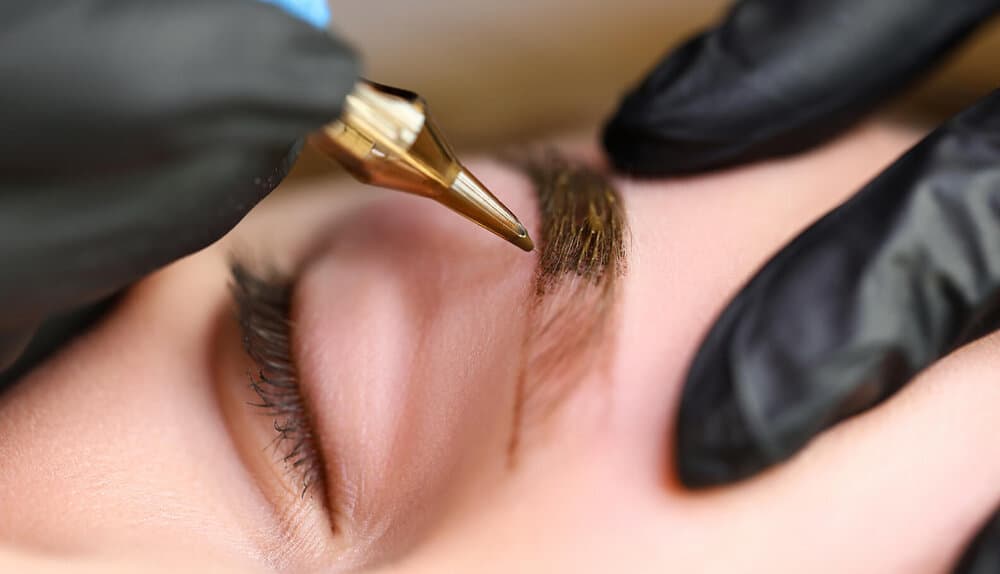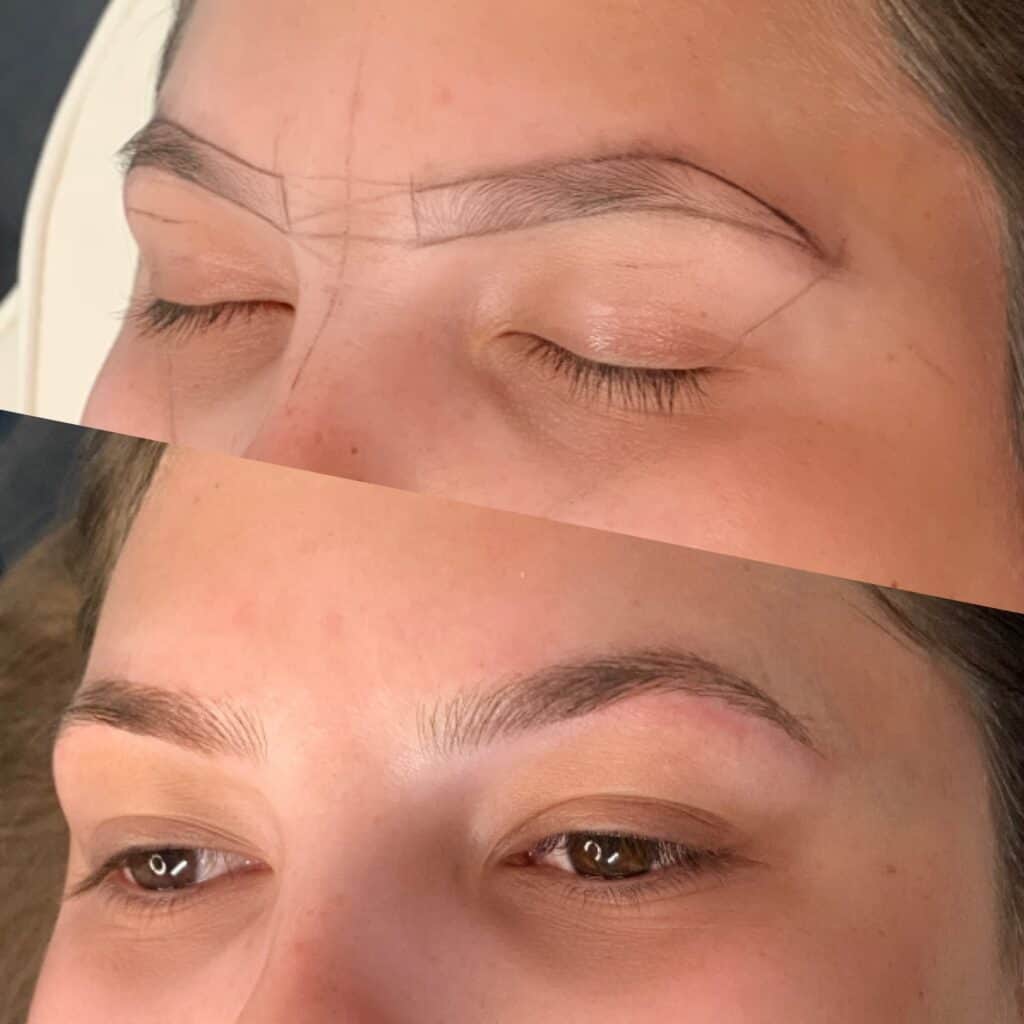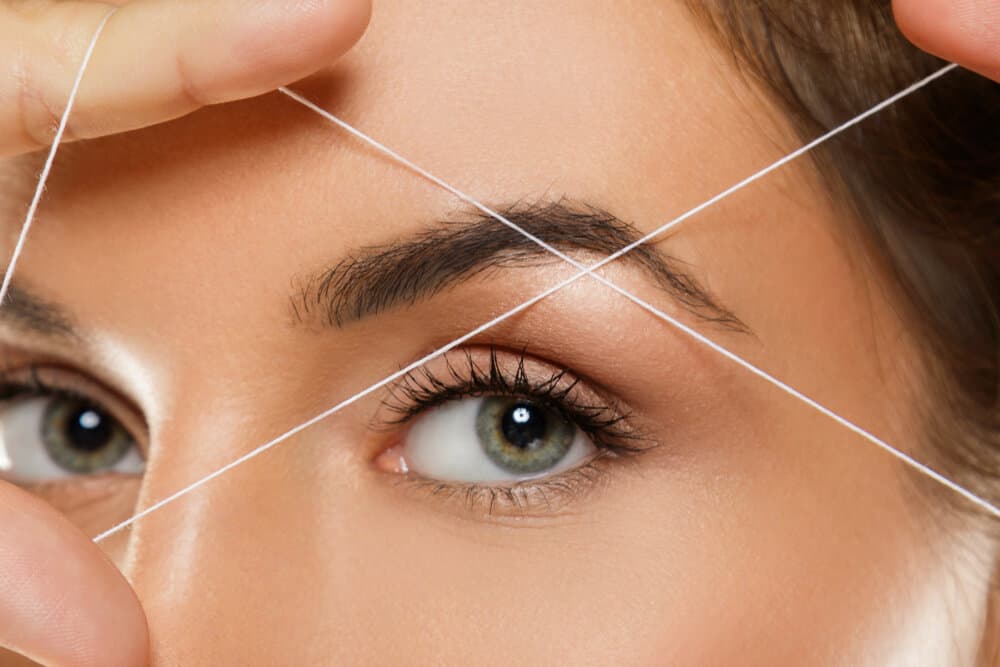Microblading | Is Microblading Permanent

Microblading is a popular cosmetic procedure used to enhance the appearance of eyebrows by creating the illusion of fuller, more defined eyebrows. This technique involves using a handheld tool to make small, hair-like strokes on the skin, which are then filled with pigment to create the desired shape and color of the brows. While microblading is a semi-permanent solution for eyebrows, people often need clarity regarding its permanency. In this response, we will investigate whether micro blading is permanent and what factors can affect its longevity.
How Microblading Works
Microblading Technique
Microblading is a manual technique where the artist uses a small handheld tool with wonderful needles to create tiny hair-like strokes on the eyebrows. The device is dipped into the pigment and then used to make small incisions in the skin, where the stain is deposited. The result is a natural-looking eyebrow that blends seamlessly with the client’s existing eyebrow hairs.
Microblading Process
The microblading process typically begins with a consultation to discuss the client’s desired outcome and to assess their skin type, eyebrow shape, and facial features. The artist will then use a pencil to draw on the desired eyebrow shape, which the client can approve or adjust. Once the body is agreed upon, the artist will use the microblading tool to create the hair-like strokes. The artist will continue to work on the eyebrows until the desired look is achieved, and then the pigment is allowed to be set for a few minutes before any excess is wiped away.
Healing Process
After the microblading procedure, the client’s eyebrows appear darker and more defined than the final result. The pigment will also appear slightly red and irritated, as the skin has been punctured during the procedure. It is usual for the eyebrows to scab over in the days following the process, and the pigment will appear to be flaking off. It is crucial not to pick at the scabs or flakes, as this can remove the stain and affect the final result. Over the next few weeks, the pigment will settle into the skin, and the eyebrows will appear lighter and more natural-looking. The healing process can take anywhere from a week, during which time the client should avoid sweating, swimming, or any activities that may cause excessive sweating or rubbing of the eyebrows.
Microblading Longevity
Factors Affecting Microblading Longevity
Microblading is a semi-permanent cosmetic tattooing that creates natural-looking, fuller, and more defined eyebrows. The longevity of microblading can be affected by various factors, such as skin type, age, sun exposure, lifestyle, and skincare routine. People with oily skin may experience faster fading than those with dry or normal skin. Older individuals may also experience faster fading due to slower cell regeneration and turnover. Overexposure to sunlight and UV rays can cause fading and discoloration of the pigment, and activities such as swimming, sauna, and excessive sweating may cause the stain to varnish faster. Using harsh chemicals or exfoliating agents on the eyebrow area can also cause the pigment to fade more quickly. Microblading typically lasts anywhere from one to three years, depending on these factors, and touch-up appointments may be needed every six months to one year to maintain the desired look. Proper aftercare, such as avoiding sun exposure, excessive sweating, and harsh chemicals, can help prolong the longevity of the micro blading and minimize the need for frequent touch-ups.
How Long Microblading Lasts
Microblading typically lasts anywhere from one to three years. Still, the longevity of the procedure depends on various factors such as the individual’s skin type, age, sun exposure, lifestyle, and aftercare routine. People with oily skin may experience faster fading, while older individuals may experience slower healing and fading due to slower cell regeneration and turnover. Overexposure to sunlight and UV rays, swimming, sauna, excessive sweating, and using harsh chemicals or exfoliating agents on the eyebrow area can cause the pigment to fade faster. Touch-up appointments may be needed every six months to one year, depending on how quickly the stain disappears and how often the individual engages in activities that may cause fading. Proper aftercare can help prolong the longevity of the micro blading and minimize the need for frequent touch-ups.
Touch-ups And Maintenance

Microblading typically lasts anywhere from one to three years, depending on the individual’s skin type, lifestyle, and aftercare routine. However, touch-up appointments may be needed every six months to one year, depending on how quickly the pigment fades and how often the individual engages in activities that may cause fading. Proper aftercare, such as avoiding sun exposure, excessive sweating, and harsh chemicals, can help prolong the longevity of the micro blading and minimize the need for frequent touch-ups.
It is recommended to schedule a touch-up appointment six to eight weeks after the initial microblading procedure to ensure proper healing and address any areas needing additional pigment. By maintaining a good aftercare routine and scheduling regular touch-ups, individuals can maintain the desired look of their microblade eyebrows.
What Is The Difference Between Microblading And Traditional Tattooing
Microblading and traditional tattooing are both body art forms that use a blade to create small, precise lines on the skin. The main difference between microblading and traditional tattooing is that with microblading, tiny needles are used instead of a large knife. This makes for a much finer and more delicate line, which results in a more realistic appearance. Because less ink is involved overall, microbladed tattoos heal faster than traditional tattoos. Microblading generally does not cause as much pain as conventional tattooing. Most people report feeling little to no discomfort during the process. However, there is a slight chance of experiencing minor bruising and soreness around your tattoo area afterward. If either of these symptoms persists or gets worse, be sure to consult with your doctor.
What Factors Can Affect The Longevity Of Microblading
The longevity of microblading, a cosmetic tattooing technique for creating fuller eyebrows, depends on several factors. One of the primary factors is the depth at which the pigment is inserted into the skin; if the stain is not inserted deeply enough, the results may fade more quickly. Other factors that can affect the longevity of microblading include the individual’s skin type, the quality of the pigment used, and exposure to the sun, water, and other elements that can cause fading. The skill and technique of the microblading artist are also important, as a skilled artist can better create a result that will last longer. Regular touch-up sessions can help maintain the longevity of micro blading, and the use of aftercare products and avoiding certain activities can also help to protect the results.
What Are The Potential Risks Or Complications Associated With Microblading
Microblading is a cosmetic procedure that involves using a small handheld tool to create hair-like strokes on the skin, which are then filled in with pigment to give the appearance of fuller, more defined eyebrows. While microblading is generally considered safe, individuals should be aware of potential risks and complications before undergoing the procedure. One potential risk of microblading is an infection, which can occur if the tools or pigments are not adequately sterilized. Individuals may also experience allergic reactions to the dyes used in the procedure, which can cause itching, swelling, or redness. Microblading may result in scarring or keloid formation, particularly if the individual has a history of hypertrophic scars. If the microblading is not performed correctly, the results may appear uneven or unnatural, requiring additional touch-up treatments or even disciplinary procedures.
Are There Any Alternative Options To Microblading For Achieving Fuller Or More Defined Eyebrows

One popular alternative is eyebrow tinting, which involves using semi-permanent dye to enhance the color and shape of your eyebrows. This can be a good option for those who want to achieve a more dramatic look without the commitment or cost of microblading. Another option is eyebrow threading, which involves using a thin thread to remove unwanted hair and shape the eyebrow area.
How Can I Ensure That My Microblading Lasts As Long As Possible
Microblading is a popular cosmetic procedure that uses a handheld tool to create small, hair-like strokes on the eyebrow area, giving the appearance of fuller and more defined eyebrows. While the results of microblading are semi-permanent and can last for up to two years, there are several things that you can do to ensure that your microblading lasts as long as possible. Choosing a skilled and experienced microblading artist who uses high-quality pigments and equipment is essential. This will help to ensure that your microblading is done correctly and that the dye is deposited evenly into the skin, which can help to prolong the results. After the procedure, following the aftercare instructions provided by your microblading artist, typically avoiding exposure to water, sweat, and sun for a few days, is essential. You should avoid picking at or scratching the treated area, as this can cause the pigment to fade prematurely.
How Long Will It Take For My Skin To Heal After A Microblading Session
The healing time after a microblading session will vary depending on the severity of the procedure and your skin type. Typically, most people see a noticeable difference within two to four days following their treatment, with good overall results seen within a couple of weeks. In some cases, minor redness or swelling may remain for up to one or two weeks afterward, but these are generally milder than average. Accordingly, following your practitioner’s post-operative instructions is essential to ensure a speedy and healthy recovery.
Microblading is a popular cosmetic procedure that uses a small amount of ink to create the appearance of eyebrows. While this procedure is relatively temporary, there is still some debate surrounding the long-term permanence of microblading. Some believe the ink may fade or disappear over time, while others think it can be permanently applied. If you are considering microblading as a potential cosmetic procedure, it is crucial to speak with a qualified professional to learn more about the long-term permanence of this procedure.
Things To Do In Temecula CA
Temecula CA News
